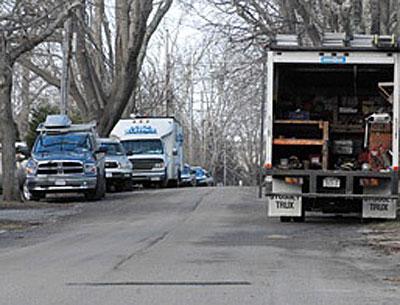At Crossroads on New Traffic Regs

Signs limiting or excluding certain vehicles, and strict enforcement of traffic regulations, are imperative to reducing congestion on residential roadways around North Main Street in East Hampton, several residents insisted at an East Hampton Town Board hearing on possible changes to traffic rules in their neighborhoods.
Speakers implored the board to ban through traffic and prohibit trucks over nine tons from accessing Cooper, Osborne, and Miller Lanes, Palma Terrace, and Sherrill Road from Cedar Street, Indian Hill Lane from Three Mile Harbor Road, and Miller Lane East and West from Oakview Highway. Trucks making local deliveries and personnel responding to an emergency would be exempt from these regulations.
In addition, the amendments being considered would add stop signs at the intersections of Downey Lanes East and West with Miller Lanes East and West, and prohibit drivers from making a left turn from Indian Hill Road onto Three Mile Harbor Road.
Chris Russo, a former East Hampton Town highway superintendent, spoke forcefully against the proposed amendments. Instead, he suggested, the board should meet with the operators of trucks, determine the routes they need, and then ban trucks from all other roads as part of a comprehensive, townwide policy.
Erecting “no through traffic” signs, he said, “looks to me to be creating de facto private roads that are going to be publicly maintained.” He encountered this situation as superintendent, he said, explaining that, as in the neighborhood in question, motorists use streets including Town Lane, Further Lane, and Bluff Road to avoid busier roads and traffic lights. “If nobody can drive on [a street] except a resident or somebody that has business on this street, isn’t it a private road?” he asked. “I’m sure that’s what the people in this affected area want. They don’t want anybody on their street except them and their friends and the people working for them.”
Mr. Russo suggested that residents who want to limit vehicular traffic in their neighborhood should petition the board to take the streets in question out of the highway system. “They can then do anything there. They can have a gate operated with a card, they can have guards, put speed bumps, have a 5-miles-per-hour speed limit. But it’s their road,” he said, and attendant expenses would become their responsibility.
“The situation is now quite dangerous,” said Julia Mead of Miller Lane West, who delivered a petition that she said bore the signatures of 80 residents. “These are narrow roads, no sidewalks, no shoulders. The conditions there present a hazard to pedestrians and bicyclists,” she said. “Over the past decade, we’ve noted an alarming increase in truck traffic and speeding cars through our neighborhood.”
The problem exists year round, Ms. Mead said. “Admittedly, it gets much worse in the summertime. But the real problem is during rush hour — in the mornings, late afternoons, and early evenings. People go to work all year round.”
Councilman Peter Van Scoyoc predicted a gridlock situation if the town forces all traffic onto main arteries. “I’m extremely concerned about the safety issues, though, and the focus really should be on those,” he said.
“My hope is that safety would trump convenience,” Ms. Mead said.
“What if we do this,” asked Councilman Dominick Stanzione, “and it doesn’t work?”
“If it doesn’t work we’re going to come back asking for sidewalks and a 20-miles-per-hour speed limit,” she answered.
Supervisor Bill Wilkinson and other board members wondered aloud if a compromise, in which restrictions and exclusions are enacted during the morning and afternoon rush hours, would resolve the issue. Residents were skeptical. Mr. Russo, however, had earlier issued his own prediction. “You will be doing it 100 times next year if this happens,” he said. The board agreed to revisit the matter in a work session.
After brief hearings, the board also approved the town’s acquisition of 5.9 acres of land at 41 Three Mile Harbor Road in Springs, at which it will establish a park, nature preserve, or recreation area, and a .44-acre parcel at 20 Gloucester Avenue and a .3-acre parcel at 117 North Greenwich Street, both in Montauk, to attenuate floodwaters, serve as a buffer against pollutants, and dissipate sediments in and around Lake Montauk.
